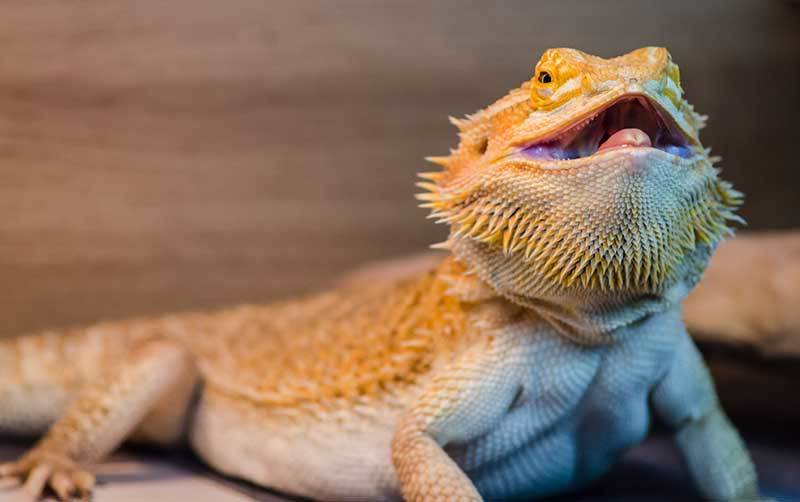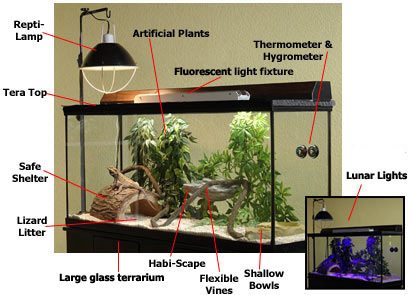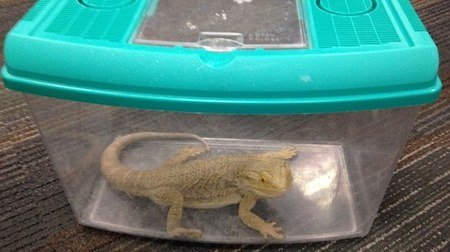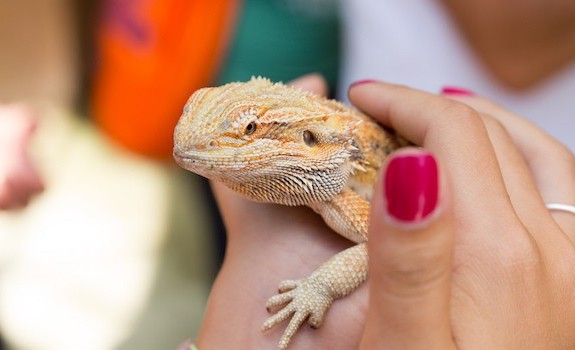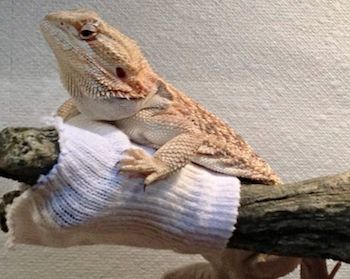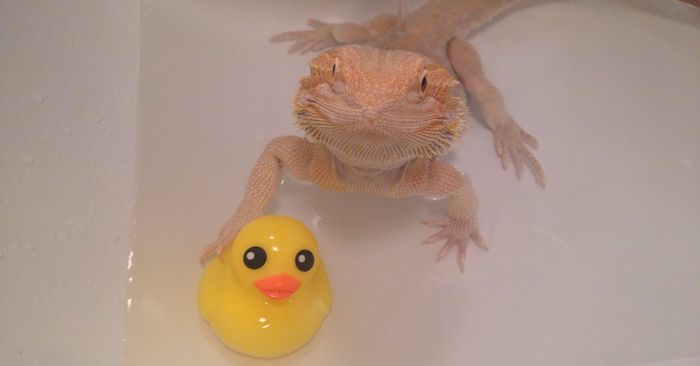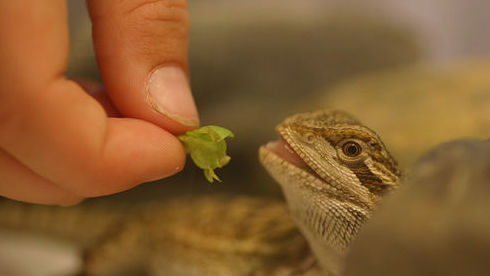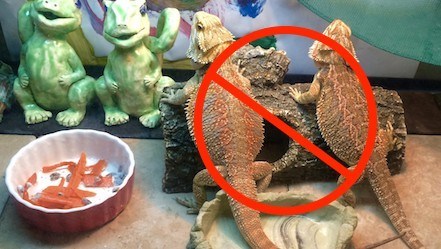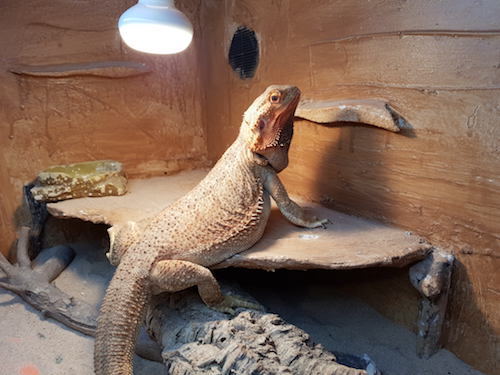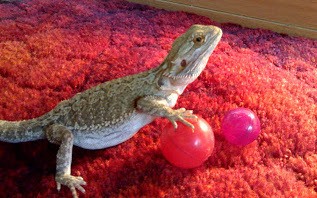Stress among bearded dragons is common, especially after you bring them home for the first time.
At this point, you may notice that they are not eating or pooping and/or have a darker coloration, which is usually the case with stressed out bearded dragons, in addition to a few other indications discussed later.
At any rate, stress can occur at any point when owning a bearded dragon.
Below are the tips and strategies I recommend on how to calm a stressed bearded dragon.
Simply keep reading OR use the Quick Navigation Table below to be taken to a specific topic.
In This Article
Causes of Stress Amongst Bearded Dragons
Before we get into the strategies, it’s important to first consider the common causes of stress…
There is no simple fix when it comes to calming down a bearded dragon as there is no one size fits all solution.
However, taking the time to understand these various causes will (hopefully) help you to more quickly and easily identify the cause so that you can the proper adjustments.
Not Having Their Habitat Set Up Correctly
This is where you should start after you first notice any signs of stress since a large component of external stress is caused by whether their environment is set up properly.
Failing to provide crucial things such as proper lighting, temperature gradient, furniture, and substrate could be the root of what is causing your bearded dragon to feel this way.
Click HERE to read about how to set up the perfect habitat for a bearded dragon
Relocation
After you first bring home your new bearded dragon, whether it be a baby, juvenile, or adult, it will surely feel stressed out for a certain period. This is normal, quite common, and should also be expected.
Relocation stress occurs for a handful of reasons, such as undergoing a change in their environment, experiencing new sights, sounds, and smells, in addition to feeling overwhelmed by a potential barrage of new people congregating in front of the tank.
This type of stress can last several days and up to a week in most cases as it takes some time for your dragon to acclimate to their new environment. However, in more severe instances, this may even last up to a month.
Click HERE to read about how to safely transport and travel with your beardie
How to Calm a Stressed Bearded Dragon
Luckily, there are several things that you can do to make your bearded dragon feel at ease more quickly…
Reduce handling to a minimum
If you notice that your beardie is frightened by you in any way (i.e. trying to get away from you, acting defensive, hiding, etc.), then it is best if you avoid handling them all together until they feel more comfortable and fully settle into in their tank.
For time reference, this process could be a period of up to an entire week.
Instead of immediately trying to handle them, try placing your hand in their tank with your palm up for several minutes at a time instead.
This will display to your dragon that you’re not going to hurt them and give them a chance to slowly (and comfortably) get use to you.
Minimize Sensory Overload
Just as humans can become over-stimulated by their environment from excess noise, technology, and by being around large crowds, excess sensory intake for bearded dragon can cause them to feel overwhelmed which can ultimately lead them to become stressed out.
You can reduce your beardies reaction to sensory inputs (such as spectators) by covering the tank with a towel or getting a good background.
Get Them Used to Your Scent
Another way to help your beardie overcome relocation stress faster is to try and make them feel more comfortable with not only their environment, but you as their owner as well. This is also one of the many ways you can initiate bonding with your pet.
One way to do this is by get them use to your smell. Simply place an article of your clothing in their cage so they’re able to more quickly become familiar with your scent.
Give Them a Warm Bath
Consider welcoming them home with a warm and soothing 20-minute bath which will help keep them hydrated in addition to getting them clean.
Just make sure the water is between 85 and 92 degrees F and that you don’t get it in either their eyes or nose.
Also, something important to note here…when picking your beardie up to bathe, it is best to avoid reaching from above their head since doing so can startle them.
In the center of their head is a third eye which is capable of detecting both light and shadow that may cause them to mistake your hand as a threat.
Instead of the maneuver above, try picking them up from either their side or front.
Make sure that you’re also supporting their body, legs, and tail as beardies need to feel secure when being held.
Offer Food Daily
Consistently offering live food in addition to greens can really make a difference when it comes to destressing your beardie.
So, offer both even if they’re not consuming them or demonstrating any interest.
If crickets are your choice of food, then be sure to not leave any uneaten insects inside the cage.
Removing these crickets is best since they’ve been known to attack and nibble on beardies.
NO Roommates
If you already have a bearded dragon at home, consider keeping your new beardie in a separate tank as there are known issues such as bullying among dragons from sharing an enclosure.
Bigger beardies are capable of bullying other littler dragons by taking the best food or basking spots which can result in your new dragon feeling more stressed out.
Use a Pleasant Tone
Did you know bearded dragons have excellent hearing? Speaking slowly and softly to them will come across as less frightening, intimidating, and overall calmer.
This technique is especially helpful as you advance towards their tank.
Doing so will give them the opportunity to know you’re there before they see you as to avoid creeping up on them.
Signs and Symptoms that Result from Relocation Stress
As mentioned before, common signs that result from relocation could include a darker beard and/or appearance in addition to not eating or pooping.
However, additional signs of relocation stress also include low activity levels/lethargy, smelly/runny poop, and hard urates.
Other Common Causes of Stress Amongst Bearded Dragons
Now that you hopefully have a better understanding of how to deal with relocation stress, let’s discuss other common causes of stress amongst bearded dragons.
Not Offering a Large Enough Space
Like humans needing enough space to avoid feel closterphobic, bearded dragons also need adequate space to feel good about roaming around.
As your beardie gets older and grows bigger, they may not comfortably fit in the same cage they once had as a youth, so you may need to adjust.
It is recommended that you have a tank of at least 40 gallons if not bigger for adults since having enough space is crucial for a happy and healthy bearded dragon.
Click HERE to read about the best sized tank for a bearded dragon at any age
Not Avoiding Loud Noises
We know that beardies can hear very well.
This means that loud music, yelling, thunderstorms, helicopters, etc. can all have a large impact on your beardie’s health.
They are also immensely attuned to vibrations in addition to being able to pinpoint someone’s movement.
Not Providing Enough Enrichment
Be sure you’re filling your beardie’s schedule with plenty enrichment opportunities like fun activities and toys to play with.
Failure to do so will result in a very bored and upset bearded dragon!
Click HERE to read about MUST Have Bearded Dragon Toys and Accessories
Additional Factors that Contribute to Undue Stress:
- Feelings of over stimulation
- Not being given consistent food / feelings of being hungry
- Extreme temperatures
Wrapping up on How to Calm a Stressed Bearded Dragon
Knowing that your beardie could be stressed out is likely going to concern and worry you.
Although difficult, it is important to not give into the urge of wanting to tamper with your setup as this will potentially add to the confusion and further stress out your dragon.
Focus on keeping the lights and other accouterments inside of your tank in the same place and be sure to consistently offer both food and water.
It is crucial during this time that you keep a close eye on them as this is a very delicate time in their lives. And you want them to live as long as they can.
Any drastic changes or strange behavior should be taken seriously with a visit to the vet.
But hopefully your beardie’s feeling better now, so we recommend checking out the best bearded dragon memes we found to brighten your day!
Read These Articles Yet?
How to Bond With Your Bearded Dragon
150+ BEST Bearded Dragon Names
Ultimate Bearded Dragon Care Guide
